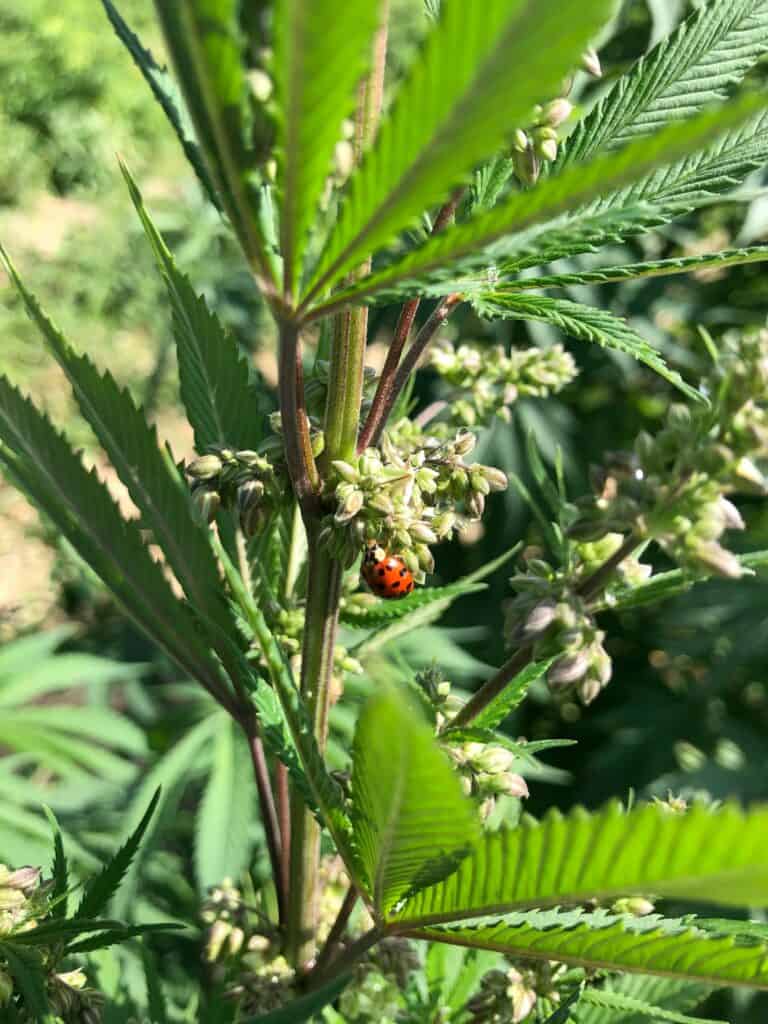TABLE OF CONTENTS
Sexing marijuana plants is a crucial part of the growing and breeding process. Cannabis plants are generally dioecious plants, which means that they will produce either female or male reproductive organs.
In certain environmental conditions, however, cannabis plants can be monoecious, also known as “hermaphroditic.” Monoecious plants feature both male and female reproductive organs.
When growing from seed, growers keep a close eye on early plant growth to make sure they know which plants are female and which are male.
Knowing the difference between the sexes tells growers whether the plant will be used to grow trichome-rich and dense flower buds or to produce exciting new genetics.
If you’re exercising your green thumb with cannabis plants, here’s everything you should know about sexing marijuana plants as early as possible.
Commonly asked topics and questions in regards to sexing cannabis are:
What is early sexing marijuana plants?
How to sex cannabis?
How to identify male marijuana plants early?
What is the difference when observing Male and Female marijuana plant comparisons?
When can you tell if your plant is male or female?
The ability to tell whether a marijuana plant is male or female is one of the most important abilities a grower can acquire in the field of cannabis cultivation. Growers need to be able to do this so they can select the appropriate genetics for their crop.
This technique, which is referred to as “sexing,” is necessary because only female plants produce the cannabinoid-rich flowers that are sought after for usage in both medicinal and recreational settings. On the other side, male plants are the ones that produce pollen, which, when transferred to female plants, might result in the development of seeded buds.
An in-depth look into the art and science of determining the gender of marijuana plants is presented here.
The Importance of Sexing Marijuana Plants
When cannabis growers obtain a marijuana clone, the clone will have the same sex as its mother. However, cannabis grown from seeds, even those advertised as “feminized seeds,” requires careful attention during their growth phase.
There is a strong likelihood that as many as half of your marijuana seeds will grow into male plants.
If you’re trying to grow female flower buds to their maximum potential, male plants can ruin a harvest when they distribute pollen.
A single male marijuana plant can pollinate an entire cannabis grow operation. Some experts even recommend a minimum distance of 10 miles between outdoor marijuana fields to avoid cross-pollination.
Marijuana pollen can reach even further than that, but the risk is drastically lowered. Marijuana pollination is an important part of breeding new hybrid and stable genetics.
While commercial breeding operations use hundreds of plants and hunt for the most desirable phenotypes, home growers are generally limited to small-batch breeding by government cultivation limitations.
If a female marijuana plant gets pollinated, it stops growing flower buds and switches to seed production. Non-pollinated female plants are also known as sinsemilla, meaning “without seeds.”
These plants produce the most terpene- and cannabinoid-rich flower buds. Removing male plants from the garden as soon as possible keeps your female crop intact and growing flowers.
Before delving into the nuts and bolts of the process, it is critical to gain an understanding of why the sexuality of a marijuana plant is so important.
The production of buds occurs when female plants are not pollinated, at which point they generate enormous, sticky buds. Cannabinoids like THC and CBD are primarily extracted from the buds of the cannabis plant.
When male plants pollinate female plants, the female plants generate seeds, which can lower both the quality and quantity of cannabis that can be used. This process is known as seeding.
Sexing Weed Plants

In order to determine the sex of your marijuana plant, you’ll need to pay close attention to the area of the plant where sexual organs grow.
Identifying the Sex: Marijuana plants start showing their sex during the flowering stage, but with careful inspection, signals can be determined even earlier. The flowering stage is the time when marijuana plants begin to exhibit their sex.
A cannabis plant’s sexual organs grow at the nodes, where the base of the leaf stalk (petiole) attaches to the main stem. Growers should use a loupe or hand-held magnifying glass to locate and monitor stipules at these nodes.
Stipules resemble two narrow spikes, one on either side of the node. Examine the node region every day for calyxes emerging from the stipules.
- If the calyx is raised on a small, short stem, and staminate primordia (small sacs) are growing between the nodes, it’s probably a male plant.
- If pistillate primordia (two fuzzy white hairs) are growing between the nodes and the calyx is not raised on a small short stem, it’s a female plant.
Growers can get a good idea of whether a plant is male or female earlier in the flowering cycle, even without seeing the reproductive organs.
Pre-flowers: Before the plant enters the flowering stage in its entirety, little structures known as pre-flowers begin to grow at the nodes (which are the points where branches emerge from the main stem). It is possible to determine the gender of the plant based on its pre-flowers.
Male pre-flowers have the appearance of little round balls most of the time. It's possible that they'll grow on a thin stem.
Female pre-flowers are more in the shape of a teardrop and will have a pair of very fine white hairs, known as pistils, emerging from the center of them.
At this stage, the plant is in the flowering stage, and the male flowers look like little bunches of bananas or grapes. They are pollen sacs, and when they burst open, the pollen they contain will be released.
Female Flowers: Female flowers, when they mature, develop into the typical bud structure, with many white pistils emerging from them. Female flowers can be identified by their maturation process.
If seeds of the same strain are planted at the same time, the difference in sex will usually manifest in different heights.
Female plants tend to grow shorter and bushier compared to male plants. Female plants also have a larger number of leaves near the top than males (where flowers will form).
As you grow more plants, you’ll learn to determine the sex of your plants during the vegetative stage of growth. Novice growers may take a few weeks longer to determine the sex of the plant. You should be checking the nodes every day for calyxes growing from the stipules.
At the very latest, plants will show their sex two or three weeks after the light schedule is switched to 12 hours of light and 12 hours of darkness each day.

Removing Male Weed Plants
Remove male marijuana plants as soon as you determine their sex. Male marijuana plants produce a scant number of flowers with very low THC levels.
Still, there are many great uses for male cannabis plants. Instead of discarding your male plants, here are a few ways to make the most of them:
- Breed new genetics by pollinating select female plants.
- Juice the leaves of male cannabis plants or put them in a salad.
- Extract cannabinoids from male plants’ leaves, stems, and sacs to produce concentrates.
- Use the soft hemp fiber produced by male plants to make clothing and other textiles
Sexing marijuana plants gets easier the more times you do it. At first, you may have trouble identifying the distinct characteristics of the cannabis plant’s male and female reproductive organs. But with daily observation, you can catch those male plants early.
Tips To Sex Marijuana Plants
Examining the Pre-Flowers
Under a Microscope Either a jeweler's loupe or a tiny microscope can be used to examine the pre-flowers in great detail. This can be especially helpful in the beginning phases, when the differences between the two are still rather modest.
Through the process of cloning, some cultivators take a little cutting from a plant and push it to flower. This enables them to determine the sex of the original plant without having to wait for it to enter the flowering stage of its life cycle naturally. Cloning is also used to propagate new plants.
Manipulating Male Plants
Once you have determined which plants are males, you will most likely wish to get rid of them so that the female plants are not pollinated by the males. Nevertheless, there are a few notable exceptions:
Breeding: If you are actively trying to create new strains, you should make sure to maintain a few men around so that they can pollinate the females.
Cannabinoids are not completely absent from male cannabis plants, despite the fact that their concentrations are lower than those of female plants. Extracts and consumables may be harvested from male plants by some cultivators.
Growers often choose to use feminized seeds so they can avoid the time-consuming procedure of sexing their plants. These seeds have been selectively bred to ensure that they only generate female plants. Although they do not eliminate the possibility entirely, they can greatly cut down on the number of male plants produced.
The ability to determine the sexual orientation of marijuana plants is fundamental to the cultivation of cannabis. Growers can increase their yield of high-quality buds that are free of seeds by preventing pollination of the female plants in their crop.
This keeps the plants from producing seed pods. Understanding the difference between male and female plants is essential for a successful harvest, whether of whether you are producing for your own personal consumption or for sale in a commercial setting.
Sexing Weed Plants FAQ's
Why is sexing marijuana plants important?
It is important to sex cannabis plants because only female plants make the high-quality buds that people use. Pollen from male plants can fertilize female plants, making seeded buds that aren't as strong or attractive. Accidental mating can be avoided by finding and getting rid of the male plants early in the growth cycle.
When can you start sexing marijuana plants?
Cannabis plants usually show their sex during the pre-flowering stage, which is around 4 to 6 weeks into their growth cycle. However, this can be different for each type and growing conditions. Some plants may show their sex earlier, especially if they are stressed or if you use certain methods to get them to bud early.
How do you tell if a marijuana plant is male or female?
Female plants make pre-flowers that look like small buds or bracts. These buds or bracts turn into hair-like structures called pistils. It is easy to tell that a plant is female because it has pistils that are generally white or orange.
“
There are over 300,000 jobs in the cannabis industry. CTU trained me for one of them!
 - Johanna Rose
- Johanna Rose
Makes $24.50 @ THC +
Male plants make small structures that look like balls and turn into pollen sacs. In time, these sacs will open up and let the pollen out. Most of the time, male pre-flowers grow on short stalks.
What are hermaphrodite cannabis plants?
Cannabis plants that are hermaphrodites have both male and female reproductive parts. This can happen because of your genes or as a reaction to stress. Hermaphrodites can mate both themselves and other female plants, which makes buds with seeds. It is very important to keep hermaphrodite plants out of the grow area so that they don't pollinate other plants by mistake.
Can you influence the sex of a marijuana plant?
A plant's sex is determined by its genes, but stress in the environment can cause it to grow traits that make it hermaphroditic. There are, however, no surefire ways to change a plant's natural sex. A popular way to make sure you get a female crop is to grow feminized seeds, which are designed to only grow female plants.
What should you do with male marijuana plants?
In order to keep male plants from mating female plants, they are usually taken out of the grow area. In contrast, they can be used for breeding, making hemp fiber, or gathering pollen for trials in controlled breeding.
How accurate is pre-flowering sexing?
If you are careful, pre-flowering sexing can be very accurate, but you need to know what you're doing and sometimes use tools that magnify things to see the small pre-flowers clearly. It's easy to make mistakes, especially when trying to tell the difference between early male and female pre-flowers.
What are feminized seeds, and how do they affect sexing?
Almost all of the time, feminized seeds grow into female plants. Getting a female plant to make pollen and then using that pollen to breed another female plant is how they are made. When you grow plants from modified seeds, they are almost always female, so you don't have to sex them.
Cannabis College Courses Online
Ready to learn more about growing techniques from the leading online Cannabis School? Invest in Cannabis Training University’s certification programs for a well-rounded education on everything from cannabis laws to growing a career in the industry.
Enroll today at the best marijuana school. Get a marijuana job and begin that cannabis career you've been dreaming about!

Luis Cordova
Luis Cordova is a distinguished author, and renowned expert in cannabis cultivation, who possesses a Master's degree in Plant Biotechnology and Pharmaceutical Science. As a valued contributor to highly esteemed publications such as Cannabis Training University and Maximum Yield Magazine, Luis has emerged as a trusted source of guidance and knowledge in the cannabis industry. Having written thousands of informative articles, Luis is widely recognized for his comprehensive expertise on cultivating cannabis, both indoors and outdoors.












 Jeff was involved in an accident where he endured a traumatic brain injury. He had a week-long stay in ICU where brain surgeons
Jeff was involved in an accident where he endured a traumatic brain injury. He had a week-long stay in ICU where brain surgeons  100% risk free money back guarantee within 48 hours after purchase if student has not completed any of the courses or exams.
100% risk free money back guarantee within 48 hours after purchase if student has not completed any of the courses or exams.